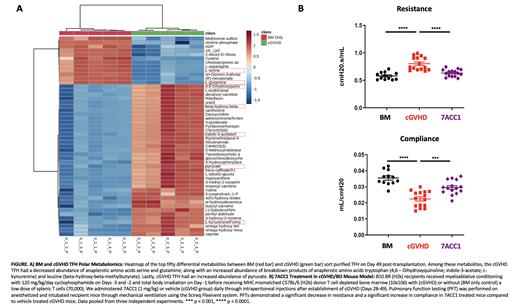Allogeneic hematopoietic stem cell transplantation (allo-HSCT) is a potent therapy for many hematopoietic diseases and malignancies. However, the long-term efficacy of allo-HSCT is limited by the development of chronic graft versus host disease (cGVHD). During cGVHD, interactions between donor-derived T follicular helper cells (TFH) and germinal center B cells (GCB) result in the production of alloreactive class-switched affinity-matured antibodies that attack host tissues, causing multi-organ damage and tissue fibrosis. Novel treatment approaches are warranted to treat cGVHD since it is often refractory to current broad immune suppressive drugs. In this study we sought to delineate the metabolic dependencies of germinal center (GC) immune cells to discover new strategies to treat active murine cGVHD.
We utilized a multi-organ mouse model of cGVHD that includes bronchiolitis obliterans (BO), a severe cGVHD manifestation seen in the clinic. Toward that end, B10.BR (H2 k) recipients received myeloablative conditioning with cyclophosphamide and total body irradiation before receiving MHC mismatched C57BL/6 (H2 b) donor T cell depleted bone marrow with (cGVHD) or without (BM only control) a low dose of splenic T cells. First, we sought to assess the metabolic dependencies of TFH during cGVHD progression through Seahorse metabolic flux assays. TFH sorted early (D28) from cGVHD mice were highly glycolytic with an increased extracellular acidification rate (ECAR) and less reliant on oxidative phosphorylation (OXPHOS) as reflected by a decreased oxygen consumption rate (OCR). However, TFH sorted later (D49) from cGVHD mice demonstrated a dramatic shift in their metabolic profile to a decreased ECAR and an increased OCR indicating a transition from glycolysis towards OXPHOS as disease progresses.
To understand which substrates are driving increased OXPHOS and to identify promising metabolic targets, we performed unbiased metabolomics of sort purified TFH from BM only and cGVHD mice on D49 post-transplantation (Fig A). Among the top fifty differential metabolites, cGVHD TFH had a decreased abundance of anaplerotic amino acids (serine, glutamine) and an increased abundance of multiple breakdown products of anaplerotic amino acids (tryptophan, leucine), indicative of increased replenishment of tricarboxylic acid (TCA) cycle intermediates. Notably these metabolomics data showed a decreased abundance of glutamine which is consistent with an increase in glutaminolysis, validating our prior findings that TFH cells that cause cGVHD/BO depend on glutaminolysis ( Johnson MO, Cell 2018). Additionally, there was an increased abundance of pyruvate, which can be transported into mitochondria to fuel the TCA cycle through the mitochondrial pyruvate carrier (MPC).
Based on these findings we chose to target the MPC since it has a central role in tying pyruvate to the TCA cycle and OXPHOS. We assessed the effect of an MPC inhibitor (7ACC1) on the GC reaction utilizing an ex vivo co-culture assay of TFH and B cells. 7ACC1 added to this co-culture system resulted in a significant reduction in the production of class-switched immunoglobulin compared to vehicle treatment. To assess the in vivo efficacy, we administered 7ACC1 daily through intraperitoneal injections after establishment of cGVHD (Days 28-49) in the cGVHD/BO mouse model. 7ACC1 treatment resulted in a significant reduction of the GC reaction with significantly decreased TFH and GCB frequencies. Additionally, there was a significant improvement in cGVHD disease severity as evidenced by assessing pulmonary function tests in anesthetized, intubated and mechanically ventilated mice using plethysmography. In contrast to the high resistance and low compliance seen in cGVHD/BO mice, 7ACC1 treated recipients had significantly improved lung function, comparable to the BM only controls (Fig B). In summary, inhibiting MPC mediated transport of pyruvate represents a novel approach to stifling the metabolic demands of TFH as their energy dependency shifts from glycolysis towards OXPHOS during the course of cGVHD/BO disease progression.
Disclosures
Blazar:BlueRock Therapeutics: Current Employment, Membership on an entity's Board of Directors or advisory committees; Carisma Therapeutics: Current Employment, Research Funding.


This feature is available to Subscribers Only
Sign In or Create an Account Close Modal